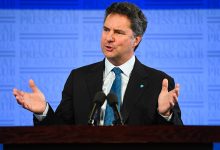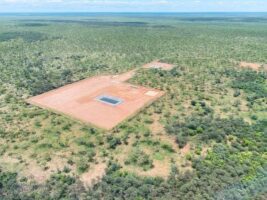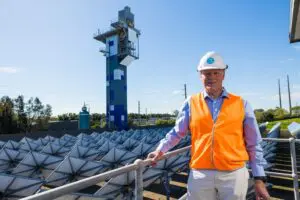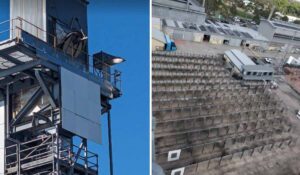The CSIRO says it will prioritise supporting Australia’s emerging green hydrogen industry, and planning for a transition to zero net emissions, as part of a set of new research ‘missions’ that will guide scientific agency’s response to Covid-19 and wider challenges faced by the Australian economy.
On Wednesday, the CSIRO unveiled a series of a dozen research ‘missions’ that will guide the agency’s work going forward, backed by $100 million a year in funding and which stretch across fields of research needed to tackle challenges that include climate change, Covid-19, more productive and resilient agricultural production and how to improve the value-adding of Australian resources.
“While COVID-19 will undoubtedly continue to disrupt, Australia will come together through this crisis and build a strong future in the process. We are calling for partners to join this Team Australia approach to solving what seem like unsolvable problems,” CSIRO chief executive Dr Larry Marshall said in a statement.
Key priorities included within these missions include growing Australia’s renewable hydrogen industry, as well as guiding a transition to zero net emissions “without derailing our economy”.
It is an interesting use of language by Australia’s leading scientific organisation, adopting a political bent to its rhetoric about the need to reduce emissions without damaging the economy. It echoes the messaging of federal energy and emissions reduction minister Angus Taylor and is perhaps the language necessary to secure the support of the Morrison government.
Most assessments of the opportunities available to Australia through a transition to net zero emissions, including those completed by leading market bodies like the Australian Energy Market Operator, suggest that Australia would be economically stronger following a transition away from fossil fuels.
At the very least, the proposal has received an endorsement from the federal science minister, Karen Andrews, who welcomed the launch of the CSIRO’s missions.
“Science and technology are our greatest tools when it comes to maximising opportunities and addressing the challenges that face Australia at this time of great upheaval,” Andrews said.
“We need to make sure that our scientists and researchers are working collaboratively with industry to solve real world challenges for the benefit of everyday Australians.”
The plan has also received the backing of Australia’s chief scientist, Dr Alan Finkel, who prepared the National Hydrogen Strategy which was adopted by federal and state energy ministers last year.
“Great science starts with a vision, but vision alone is insufficient. The vision has to be backed by real commitment. That’s what the CSIRO missions are all about, and I hope their rallying call is heard far and wide,” Dr Finkel said.
Additional ‘missions’ to be prioritised by the CSIRO will include building Australia’s preparedness for pandemics, resilience to drought, bushfires and floods, and driving innovation in Australia’s food production sectors.
The CSIRO missions were launched by chief executive Larry Marshall through a speech at the National Press Club, who said the world was currently experiencing unprecedented challenges in climate change and Covid-19, and the world has turned to science to look for how to respond.
“This generation is living through a perfect storm of bushfires, pandemic, and recession,” Dr Marshall told the National Press Club. “Never in our lifetime has a country – or the world – turned to scientists in the way they are now. History will judge us by what we do next, and our children will live with the consequences.”
“We will commit at least $100 million annually to this program, and we are calling for partners to join us in a Team Australia approach to solve our seemingly unsolvable challenges. The missions under development for Australia imagine a future where we use science to amplify Australia’s global advantages and strengths.”
“A future where we save the 170 billion of export dollars we already create from coal, LNG and iron ore by building an Australian hydrogen industry to reduce the emissions but not the profits from a key pillar of our economy,” Marshall added. “Where we leap towards net zero by establishing the first net zero emissions region in Australia.”
Marshall called on universities and other research institutions to contribute to the research effort and appears to have already won the support of the Australian National University.
“ANU looks forward to working with CSIRO and its partners to co-design and deliver a national effort to help address some of the globe’s greatest challenges. At this moment, collaborative effort has never been more needed, and ANU will happily answer the call,” ANU vice-chancellor Brian Schmidt said.
The launch of the new set of CSIRO missions coincides with the 100-year anniversary of the completion of what the CSIRO considers its first successful mission; the elimination of the introduced invasive species, the prickly pear.
Dr Larry Marshall said the agency’s century-long record of innovation should provide confidence that the agency could deliver on the new set of priorities.
“For over a century we have worked with scientists around the country to solve our greatest challenges, and find the opportunities that give Australia her competitive advantage. From our first mission to save our agricultural land from prickly pear, to discovering breakthroughs like fast WiFi, grey scale ultrasound, Australia’s first digital computer, our 70-year history in battling bushfires, and our latest vaccine, virus and surgical mask work for COVID-19, CSIRO has always made Australia’s success our mission,” Marshall said.
It is not yet known what the new priorities may mean for the CSIRO’s existing projects. In June, the agency revealed that up to 40 jobs could be cut from the CSIRO’s energy wing, with the public service union, the CPSU, fearing that further cuts could be announced in the federal budget to be delivered in October.










